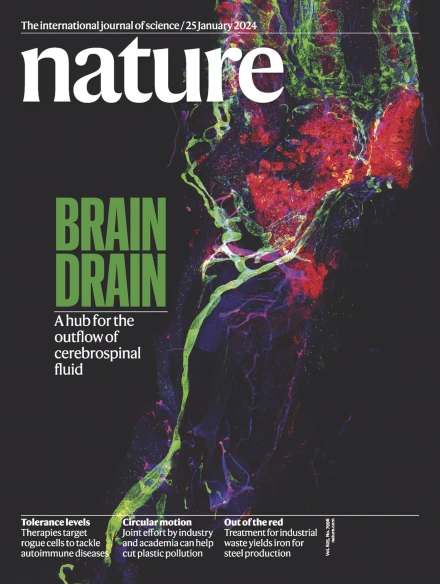双层纳米石墨烯揭示了卤化物通过苯洞的渗透过程
IF 48.5
1区 综合性期刊
Q1 MULTIDISCIPLINARY SCIENCES
引用次数: 0
摘要
石墨烯是一种单层sp2杂化碳同素异形体,除氢1,2外,它对所有原子实体都是不渗透的。引入缺陷允许选择性气体渗透3,4,5;为了获得更高的选择性,已经努力控制这些缺陷的大小6,7,8,9。除气体以外的其他实体,如离子10,11的渗透,由于其在海水淡化、检测和净化方面的潜在应用12,13,14,15,16,具有重要的科学意义。然而,到目前为止,对卤化物渗透的精确实验观测仍然是未知的11,15,16,17,18。在这里,我们展示了卤化物通过分子纳米石墨烯中单个苯大小的缺陷渗透。利用超分子自聚集原理,我们创造了稳定的纳米石墨烯双分子层19,20,21,22,23。由于双层纳米石墨烯的空腔只能通过两个埃大小的窗口进入,任何被困在空腔中的卤化物都必须通过单一的苯孔渗透。我们的实验揭示了氟化物、氯化物和溴化物通过一个苯孔的渗透性,而碘化物是不渗透性的。氯在单层纳米石墨烯上的高渗透性和双层纳米石墨烯中选择性卤化物结合的证据,为将石墨烯中的单苯缺陷用作人工卤化物受体(24,25)作为过滤膜(26)以及进一步创建多层人工氯化物通道提供了希望。本文章由计算机程序翻译,如有差异,请以英文原文为准。


Bilayer nanographene reveals halide permeation through a benzene hole
Graphene is a single-layered sp2-hybridized carbon allotrope, which is impermeable to all atomic entities other than hydrogen1,2. The introduction of defects allows selective gas permeation3–5; efforts have been made to control the size of these defects for higher selectivity6–9. Permeation of entities other than gases, such as ions10,11, is of fundamental scientific interest because of its potential application in desalination, detection and purification12–16. However, a precise experimental observation of halide permeation has so far remained unknown11,15–18. Here we show halide permeation through a single benzene-sized defect in a molecular nanographene. Using supramolecular principles of self-aggregation, we created a stable bilayer of the nanographene19–23. As the cavity in the bilayer nanographene could be accessed only by two angstrom-sized windows, any halide that gets trapped inside the cavity has to permeate through the single benzene hole. Our experiments reveal the permeability of fluoride, chloride and bromide through a single benzene hole, whereas iodide is impermeable. Evidence for high permeation of chloride across single-layer nanographene and selective halide binding in a bilayer nanographene provides promise for the use of single benzene defects in graphene for artificial halide receptors24,25, as filtration membranes26 and further to create multilayer artificial chloride channels. Halide permeation through a single benzene-sized defect in a molecular nanographene shows the permeability of fluoride, chloride and bromide, whereas iodide is impermeable.
求助全文
通过发布文献求助,成功后即可免费获取论文全文。
去求助
来源期刊

Nature
综合性期刊-综合性期刊
CiteScore
90.00
自引率
1.20%
发文量
3652
审稿时长
3 months
期刊介绍:
Nature is a prestigious international journal that publishes peer-reviewed research in various scientific and technological fields. The selection of articles is based on criteria such as originality, importance, interdisciplinary relevance, timeliness, accessibility, elegance, and surprising conclusions. In addition to showcasing significant scientific advances, Nature delivers rapid, authoritative, insightful news, and interpretation of current and upcoming trends impacting science, scientists, and the broader public. The journal serves a dual purpose: firstly, to promptly share noteworthy scientific advances and foster discussions among scientists, and secondly, to ensure the swift dissemination of scientific results globally, emphasizing their significance for knowledge, culture, and daily life.
 求助内容:
求助内容: 应助结果提醒方式:
应助结果提醒方式:


